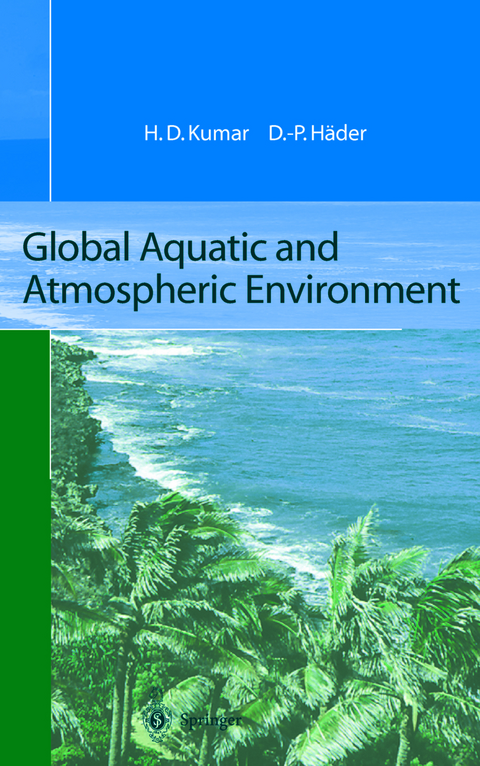
Global Aquatic and Atmospheric Environment
Springer Berlin (Verlag)
978-3-642-64243-2 (ISBN)
1 Aquatic Ecosystems.- 1.1 Introduction.- 1.2 River Ecosystems.- 1.3 Freshwater Resources and Water Quality.- 1.4 World Water Use.- 1.5 Nature of the Chemical Environment.- 1.6 Quantitative Pollutants.- 1.7 Global Change and Freshwater Ecosystems.- 1.8 Hydrological Cycle and Climate.- 1.9 Groundwater.- 1.10 Population Increase and Water Management.- 1.11 Water and the Environment.- 1.12 Freshwater Augmentation Technologies.- 1.13 Water and Development.- 1.14 Health and the Water Cycle.- 1.15 Toxicity Testing in the Aquatic Environment.- 1.16 Biological Toxicity Testing Versus Environmental Monitoring of Impacts.- 1.17 Diseases Associated with Water and Poverty.- 1.18 Restoration of Water Quality in Some Rivers.- 1.19 Rural Water Treatment for Developing Countries.- References.- 2 Lakes and Wetlands.- 2.1 Introduction.- 2.2 Trophic State.- 2.3 Interactions Between Physical and Chemical Processes.- 2.4 UV-B Effects.- 2.5 Seiching.- 2.6 Regional Lake Quality Patterns.- 2.7 Inland Lakes.- 2.8 Trophic Status and Hypolimnetic Oxygen Concentration.- 2.9 Acidification.- 2.10 Large Lakes.- 2.11 Biogeochemistry.- 2.12 Food Webs.- 2.13 Modeling of Lake Ecosystems.- 2.14 Lake Morphometry.- 2.15 Eutrophication.- 2.16 Eutrophication Control.- 2.17 Use of Ecological Indicators for Lake Assessment.- 2.18 Role of Industry in Lake Management.- 2.19 Wetlands.- References.- 3 Marine Environment.- 3.1 Introduction.- 3.2 The Intertidal Zone.- 3.3 Hydrothermal Vents.- 3.4 Marine and Coastal Pollution: Regional Sustainability.- 3.5 Living Resources.- 3.6 Marine Biodiversity.- 3.7 Oceanic Productivity and Water Color.- 3.8 Life in Oceans: Past and Present.- 3.9 Phytoplankton.- 3.10 Clouds and Sea Surface Temperature.- 3.11 Marine Plankton and Clouds.- 3.12 Ocean and Climate.- 3.13 El Niño andRelated Phenomena.- 3.14 Marine Eutrophication.- 3.15 Marine Litter.- 3.16 Disruption of Marine Ecosystems.- 3.17 Oil Spills.- 3.18 Use of Indicators to Judge the Condition of Marine Ecosystems.- 3.19 Scales of Effects.- 3.20 Scenarios.- 3.21 Shallow Water Habitats.- 3.22 Recycling in the Deep Ocean.- 3.23 Deep Water Habitats.- 3.24 Indicators of Exposure and Effect.- 3.25 Biomarkers.- 3.26 Physiology.- 3.27 Ecology.- 3.28 Marine Pollution in India.- 3.29 The Indian Ocean Law and the Environment.- 3.30 Ship Pollution.- 3.31 Waste from Land.- 3.32 Animals in Peril.- 3.33 Desalination of Seawater.- References.- 4 Ozone Changes.- 4.1 The Ozone Shield.- 4.2 Ozone Formation.- 4.3 Miracle Substances.- 4.4 Catalytic Ozone Depletion.- 4.5 The Family of Organic Reactions.- 4.6 Methyl Bromide.- 4.7 The Polar Stratosphere.- 4.8 Polar Clouds and Sulfate Aerosols.- 4.9 Ozone in the Lower Stratosphere.- 4.10 CFC Substitutes.- 4.11 Causes of Ozone Depletion.- 4.12 Ozone Layer Thickness.- 4.13 Total Column Ozone.- 4.14 Vertical Distribution of Ozone.- 4.15 Mount Pinatubo.- 4.16 Ozone Holes.- 4.17 Ozone Depletion at Mid-Latitudes.- 4.18 The Ozone Depletion Controversy.- 4.19 Ozone Trends.- 4.20 Unresolved Issues.- 4.21 Ozone Changes and Climate.- 4.22 Tropospheric Ozone.- 4.23 Impacts of Ozone and Carbon Dioxide on Crop Yields.- 4.24 The Montreal Protocol.- 4.25 Recent Ozone Developments.- References.- 5 Solar Ultraviolet Radiation.- 5.1 Introduction.- 5.2 Ozone depletion and solar UV.- 5.3 Tropospheric Transmission in the Ultraviolet.- 5.4 Measurement of UV.- 5.5 Biological Hazards of Ultraviolet Exposure.- 5.6 UV Damage to Biological Molecules.- 5.7 Health Effects.- 5.8 UV-B Effects on Plants and Terrestrial Ecosystems.- 5.9 Effects on Aquatic Ecosystems.- 5.10 Polymer Degradation.-5.11 Effect of UV-B on Air Quality.- References.
| Erscheint lt. Verlag | 13.4.2014 |
|---|---|
| Zusatzinfo | XII, 393 p. 61 illus. |
| Verlagsort | Berlin |
| Sprache | englisch |
| Maße | 155 x 235 mm |
| Gewicht | 623 g |
| Themenwelt | Naturwissenschaften ► Biologie ► Ökologie / Naturschutz |
| Naturwissenschaften ► Geowissenschaften ► Geologie | |
| Naturwissenschaften ► Geowissenschaften ► Meteorologie / Klimatologie | |
| Schlagworte | Anthropogene Umweltverschmutzung • anthropogenic pollution • Aquatic Ecosystems • Aquatische Ökosysteme • biodiversity • Climate • Ecology • ecosystem • Environment • Environmental Pollution • Limonology • Marine Ecosystems • Marine Ökosysteme • Oceanography • Ozone • ozone depletion • Ozonloch • pollution • solare UV Strahlung • solar UV radiation • Strahlung • Stratosphere • stratospheric ozone depletion • Temperature • wetland |
| ISBN-10 | 3-642-64243-8 / 3642642438 |
| ISBN-13 | 978-3-642-64243-2 / 9783642642432 |
| Zustand | Neuware |
| Haben Sie eine Frage zum Produkt? |
aus dem Bereich


